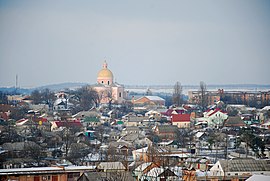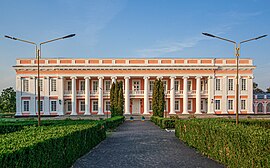Tulchyn
Tulchyn
Тульчин | |
|---|---|
| Coordinates: 48°40′28″N 28°50′59″E / 48.67444°N 28.84972°E | |
| Country | |
| Oblast | |
| Raion | |
| Founded | 1607 |
| Area | |
| • Total | 9.26 km2 (3.58 sq mi) |
| Elevation | 208 m (682 ft) |
| Population (2022) | |
| • Total | 14,446 |
| • Density | 1,600/km2 (4,000/sq mi) |
| Postal code | 23600-23606 |
| Area code | +380 4335 |
Tulchyn (
History
Tulchyn was first mentioned in written sources in 1607, under the name Nestervar.
In 1793, the Russian Empire annexed Tulchyn as part of the Second Partition of Poland. In the 1820s, Tulchyn was a centre of the movement plotting the Decembrist revolt against the Tsarist regime of Russia. A local branch of the Union of Prosperity was located in the city.[2]

Prior to the
During World War II, Nazi Germany invaded and occupied all of Vinnytsia Oblast by the end of July 1941. A large section of the region, including Tulchyn, was handed over by the Nazis to Romania, who administrated it as Transnistria Governorate. After first being confined to a ghetto, Jews from Tulchyn were deported to the nearby Pechora concentration camp where they were killed.[4] The area was liberated by the Red Army in March 1944.[citation needed]
As of 2005, the city had a population of 16,136 people.[2]
In December 2022, as part of the derussification in Ukraine intensified by the full-scale Russian invasion of Ukraine that began that year, monuments to Alexander Pushkin and Alexander Suvorov were taken down in Tulchyn.[5]
Landmarks

An important landmark of the city is the palace of the Potocki family, built according to the principles of Palladian architecture according to the plans drafted by Joseph Lacroix during the 1780s.
Gallery
-
Dominican Church in Tulchyn
-
Catholic church
-
Church of the Assumption
-
City museum
Notable people

- Stanisław Trembecki (1739–1812), Polish poet
- Włodzimierz Potocki (1789-1812), Polish Count, artillery colonel
- Mieczysław Potocki (1799-1878), Polish magnate, owner of estates in Tulczyn, one of the richest Poles in the 19th century
- Pushkinhere)
- general of Polish Army, participant of Polish National Uprisings and the Hungarian Revolution of 1848
- Marian Dziewicki (1872-1935), Polish lawyer, President of Wilno, local government activist
- Bronisław Matyjewicz-Maciejewicz (1882-1911), Polish aviator
- Mykola Leontovych (1877-1921), the Ukrainian composer (who composed the Carol of the Bells), lived here
- Sophie Tucker, Ukrainian-born American singer, comedian, actress, and radio personality
External links
- Tulchin/Tulchyn (p. 424) at Routes to Roots Foundation.
Further reading
- Weiner, Miriam; Ukrainian State Archives (in cooperation with); Moldovan State Archives (in cooperation with) (1999). "Chapter 11: Town Clips: Tulchin." Jewish Roots in Ukraine and Moldova: Pages from the Past and Archival Inventories . Secaucus, NJ: Miriam Weiner Routes to Roots Foundation. p. 424. ISBY 978-0-96-565081-6. OCLC 607423469.
References
- ^ Чисельність наявного населення України на 1 січня 2022 [Number of Present Population of Ukraine, as of January 1, 2022] (PDF) (in Ukrainian and English). Kyiv: State Statistics Service of Ukraine. Archived (PDF) from the original on 4 July 2022.
- ^ Internet Encyclopedia of Ukraine.
- ^ a b Gembarzewski, Bronisław (1925). Rodowody pułków polskich i oddziałów równorzędnych od r. 1717 do r. 1831 (in Polish). Warszawa: Towarzystwo Wiedzy Wojskowej. pp. 9, 30.
- ISBN 0965650812.
- ^ https://suspilne.media/332940-u-tulcini-demontuvali-pamatniki-suvorova-j-puskina/












